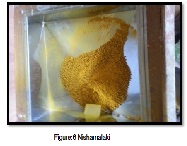Evaluation of anti-diabetic activity of Nishamlaki on streptozotocin induced type II diabetic rats
Keywords:
Madhumeha, Haridra, Curcuma longa, BSL, Lipid profileAbstract
Diabetes is a major health problem particularly in India. In spite of many drugs available, uncontrolled diabetes remains a challenge. Moreover, some of the antidiabetic drugs are on the verge of withdrawal due to adverse effects. So, there is an acute need for a new effective and safe drug. Present study was planned to evaluate anti-diabetic efficacy of Nishamalaki in diabetic wistar rats. Nishamalaki was prepared from powder of Curcuma longa and fresh juice of Emblica officinalis according to ayurvedic literature and administered with honey. Diabetes was induced in wistar rats by injection of 60 mg/kg of Streptozotocin and 110 mg/kg Nicotinamide IP. 30 rats showing blood glucose above 250 mg/dl were divided into 5 groups Group I(Control )-Saline, Group II(Control )- Vehicle honey, Group III – Nishamalaki Prophylactic, Group IV- Nishamalaki treatment & Group V- Pioglitazone, given orally for 30 days. Blood glucose levels checked at days 0, 15, 30 & Cholesterol on day 30. Nishamalaki treatment achieved significant (p<0.01) lowering of blood glucose in diabetic rats comparable to that of the Pioglitazone treated group. Nishamalaki also reduced serum cholesterol levels. Antidiabetic efficacy of Nishamalaki in diabetic rats is comparable to Pioglitazone. It has also improved the lipid profile in diabetic rats.
References
A ramachandran1 ct all, current status of diabetes in India and need for novel therapeutic agents: supplement to JAPI; June 2010, 58;7-9.
World Health Organization.Definition, diagnosis and classification of diabetes mellitus and its complications. Part 1: Diagnosis and classification of diabetes mellitus. Geneva, .(1999) (WHO/NCD/NCS/99.2)
Dr. Rajiv Gupta. Diabetes in India: Current Status, www.expresshealthcare.in Insight Into The Business Of Healthcare August 2008
Kumar Vinay, Fausto Nelson, Abbas Abul K., Cotran Ramzi S., Robbins Stanley. Robbins and cotran pathologic basis of disease (7TH ed.). Philadelphia, pa.: saunders. (2005). 1194–1195.
Fasanmade, Oa; Odeniyi, Ia, Ogbera, Ao (2008 Jun). "Diabetic Ketoacidosis: Diagnosis And Management". African journal of medicine and medical sciences 37 (2): 99–105
Awanish Pandey, Poonam Tripathi, Rishabh Pandey, Rashmi Srivatava, and Shambaditya Goswami. Alternative therapies useful in the management of diabetes: A systematic review J Pharm Bioallied Sci. 2011 ; 3(4): 504–512.
FDA Drug Safety Communication: Update to ongoing safety review of Actos (pioglitazone) and increased risk of bladder cancer, Drugs, U.S. Food and Drug Administration (FDA), 6-15-2011
Shukla R, Kalra S. Pioglitazone: Indian perspective. Indian J Endocr Metab 2011;15:294-7
Eurich D T, Simpson S, Senthilselvan A, Asche CV, Sandhu-Minhas J K, McAlister F A. Comparative safety and effectiveness of sitagliptin in patients with type 2 diabetes: retrospective population based cohort study, BMJ 2013;346:f 2267
Chaudhary A, Singh N, Kumar N. Pharmacovigilance: Boon for the safety and efficacy of ayuvedic formulations. J Ayurveda Integr Med
Parivallal, T Diabetes in Ancient India. In: Type 2 Diabetes in South Asians: Epidemiology,Risk Factors and Prevention. Sasat, (2007) :1-19.
Management of madhumeha with current evidence and intervention of ayurvedic rasaushadeis,dasbani, indian journal of traditional knowledge vol 10(4) 2011:624-628
Charak Samhita/ chikitsa sthan / Prameha Chikitsa Adhyaya, 6/289
Astanga hridhya/ chikitsa sthan /Dwadosh Adhyaya/ Prameha Chikitsa Vakhayam /5
Ghosh MN. Toxicity studies. Fundamental of experiment & Pharmacology. 3nd ed. Calcutta: Scientific Book Agency 2005:192
Faris Q. Alenzi Effect of Nicotinamide on Experimental Induced Diabetes Iran J Allergy Asthma Immunol March 2009; 8(1): 11-18
Sachin Arora, Shreesh 1 1 Kumar Ojha and 2Divya Vohora. Characterisation of Streptozotocin Induced Diabetes Mellitus in Swiss Albino Mice. Global Journal of Pharmacology, 3 (2): 81-84, 2009
Guenther Boden. Obesity and Free Fatty Acids (FFA). Endocrinol Metab Clin North Am. 2008 ; 37(3): 635
Brownlee M.The Pathobiology of Diabetic Complications.A Unifying Mechanism- Banting Lecture 2004, Diabetes, ( 54), June 2005
Parivallal T. Diabetes in Ancinet India. In: Type 2 Diabetes in South Asians: Epidemiology, Risk Factors and prevention. Mohan V, Gundu HR Rao (Eds), Under the Aegis of SASAT. Jaypee Brothers Medical Publishers. 2007; 97-103.
Tripathi KD, Essentials of Medical Pharmacology,Insulin,oral hypoglycaemic drugs & glucagon.VII the d,2013 Jaypee brothers medical publishers(P) ltd;278-279
Melo SS, Arantes MR, Meirelles MS, Jordão AA Jr, Vannucchi H. Lipid peroxidation in nicotinamide-deficient and nicotinamide-supplemented rats with streptozotocin-induced diabetes. Acta Diabetol 2000; 37(1):33-9.
K. Srinivasan , P. Ramarao. Animal models in type 2 diabetes research: An overview. Indian J Med Res 125, March 2007, pp 451-472
Ralph A. DeFronzo,Pharmacologic Therapy for Type 2 Diabetes Mellitus Annals of Internal Medicine • Volume 131 • Number 4;281-303
Rao G , Bhat S, Rao GS, Bhat GP . Antidiabetic and Antioxidant Efficacy Of a Powdered Mixture Of Curcuma Longa and Emblica Officinalis In Diabetic Rats In Comparison With Glyburide. http://www.webmedcentral.com on 25-Feb-2013, 07:29:16 AM
Babu PS, Srinivasan K. Hypolipidemic action of curcumin, the active principle of turmeric (Curcuma longa) in streptozotocin induced diabetic rats. Mol Cell Biochem. 1997; 166(1-2): 169-175.
Parminder Nain, Vipin Saini, Sunil Sharma. Antidiabetic and antioxidant potential of Emblica officinalis Gaertn. leaves extract in streptozotocin-induced type-2 diabetes mellitus (T2DM) rats Journal of Ethnopharmacology. 2012, 142(1): 65–71
Arun A, Nalini N Efficacy of turmeric on blood sugar and polyol pathway in diabetic albino rats.Plant Food Hum Nutr . (2002);57: 41-52
Aneesa Ansari, Md. Shahed Zaman Shahriar, Md. Mehedi Hassan, Shukla Rani Das, Begum Rokeya, Md. Anwarul Haque, Md. Enamul Haque, Nirupam Biswas, Tama Sarkar. Emblica officinalis improves glycemic status and oxidative stress in STZ induced type 2 diabetic model rats Asian Pacific Journal of Tropical Medicine. Jan 2014, 7(1): 21-25
Iyer U, Joshi A, Dhruv S. Impact of Amla (Embilica Officinalis) supplementation on the glycemic and lipidemic status of type 2 diabetic subjects. J Herbal Medicine and Toxicol. 2009; 3:15–21.
Guruprasad Rao, Surekha Bhat, S. Gurumadhva Rao, P. Gopalakrishna Bhat. Effect of Treatment with ‘Nishamalaki’ Powder on Glycemic Control and Markers of Erythrocyte Oxidative Stress in Diabetic Rats Compared to Troglitazone. Int. J. Pharm. Sci. Rev. Res., 2013;19(2),; 25, 127-134



